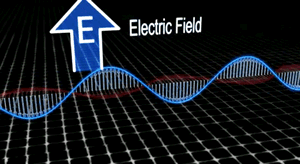Light
Why is the sky blue and the setting Sun red?
Light is a kind of energy that travels in waves. It is composed of a wave of vibrating electric and magnetic fields, as shown on the right.

Visible light is a small part of a much larger range of vibrating electromagnetic fields called the electromagnetic spectrum.
Electromagnetic waves travel through space at close to 300,000 km/sec or commonly known as the speed of light.
The energy of the electromagnetic radiation depends on its wavelength and frequency. Wavelength is the distance between the tops (crests) of the waves. Frequency is the number of waves that pass by each second.
The longer the wavelength of the light, the lower the frequency, and the less energy it contains.
White light is a mixture of different colours and can be separated using a prism.

Light travels through space in a straight line as long as nothing disturbs it. When light travels through the atmosphere it encounters dust particles or gas molecules. What happens to the light during these encounters depends on its wave length and the size of the object it hits.
Dust particles and water droplets, as in a cloud, are much larger than the wavelength of visible light. When light hits these large particles, it gets reflected. The different colors of light are all reflected by the particle in the same way so the the reflected light appears white.
Gas molecules, however, are smaller than the wavelength of visible light. When light strikes these molecules different things happen. Some of it may get absorbed and emitted back out in all directions. The light is said to be scattered. The color that is radiated out is the same colour that was absorbed. Since the different colours of light have different wavelengths they are affected differently.
Even though all frequencies of light, colours, can be absorbed the higher frequencies, such as blue and violet, are absorbed and emitted more often than the lower frequencies such as the reds.
Scattering is the reason why the sky looks blue. Blue light is predominantly absorbed and scattered in all directions giving the sky a blue appearance no matter where you look overhead.

As you look closer to the horizon, the sky appears much paler in color. To reach you, the scattered blue light must pass through more air. Some of it gets scattered away again in other directions. Less blue light reaches your eyes. The color of the sky near the horizon appears paler or white.
Why does the sun appear white when viewed from space?
Why is the colour of the lunar sky black?
When the setting Sun is near the horizon it appears red. Explain why,
Click to see the image of the wavelength of the various colours. Explain why red has less energy than violet?
Why are clouds white?
